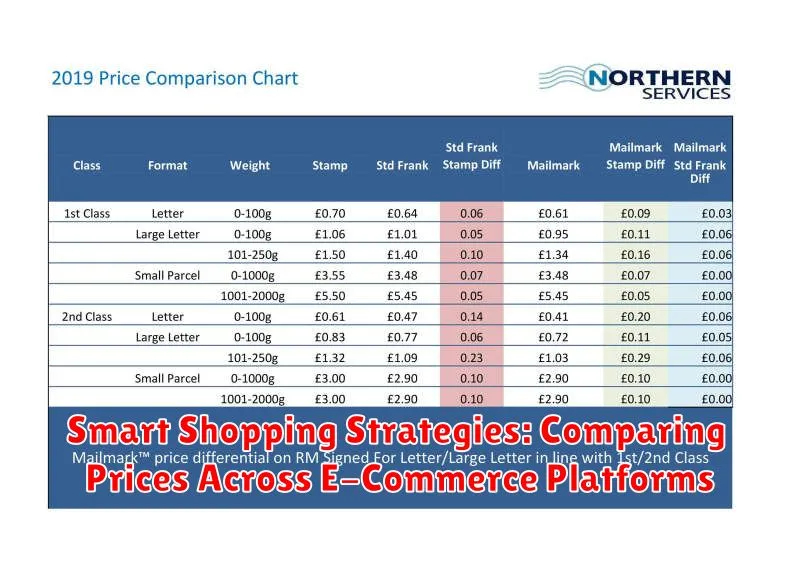In today’s dynamic digital marketplace, smart shopping has become more crucial than ever. With the proliferation of e-commerce platforms, consumers are empowered with a vast array of choices. However, navigating this expansive online retail landscape can be overwhelming. Comparing prices across different e-commerce platforms is a fundamental aspect of securing the best deals and maximizing your purchasing power. This article delves into effective smart shopping strategies, equipping you with the knowledge and tools to make informed decisions and save money while shopping online. Mastering the art of price comparison is essential for any savvy online shopper.
This comprehensive guide will explore various techniques for comparing prices across multiple e-commerce platforms. We will examine the benefits of utilizing price comparison websites and browser extensions, discuss the importance of considering factors beyond price, such as shipping costs and return policies, and offer practical tips for streamlining your smart shopping efforts. By implementing these smart shopping strategies, you can confidently navigate the complexities of online retail, ensuring you always secure the most advantageous deals and optimize your budget. From understanding dynamic pricing to leveraging coupon codes and discounts, this article will empower you to become a more discerning and cost-conscious online shopper.
Identifying Reputable E-Commerce Stores
Before making a purchase, it’s crucial to verify the legitimacy and reputation of the e-commerce store. Look for established brands with a positive online presence.
Check for contact information like a physical address, phone number, and email address. A legitimate business will readily provide these details. Secure websites utilize HTTPS, indicated by a padlock icon in the address bar. This ensures your information is encrypted during transmission.
Investigate the store’s return policy and customer service options. Understanding these policies beforehand can save you hassle if you experience issues with your order. Look for privacy policies that clearly explain how your personal data is collected and used.
Finally, research the store’s reputation by checking online reviews and ratings on independent platforms. This can give you insights into other customers’ experiences and help you avoid potential scams or unreliable vendors.
Utilizing Price Comparison Websites and Tools
Price comparison websites and tools are invaluable resources for smart shoppers. These platforms aggregate product data from numerous e-commerce stores, allowing you to quickly compare prices and identify the best deals.
By simply entering the product name or model number, you can see a list of retailers offering the item, along with their respective prices. This eliminates the need to manually visit each store’s website, saving you significant time and effort. Prioritize reputable price comparison websites known for accurate and up-to-date information.
Many of these tools also offer advanced filtering options, enabling you to refine your search based on criteria such as shipping costs, seller ratings, and product features. Some platforms even track price history, showing you how the price of an item has fluctuated over time, which can be helpful in determining the optimal time to buy.
Leveraging Browser Extensions for Price Tracking
Browser extensions offer a convenient way to monitor price fluctuations without manually checking each e-commerce site. These tools work in the background, alerting you to price drops on products you’re interested in.
Various extensions are available for different browsers, offering a range of features. Some track price history, displaying graphs of price changes over time. Others provide price alerts via email or browser notifications. Many extensions compare prices across multiple e-commerce platforms simultaneously, helping you identify the best deals.
When selecting a price tracking extension, consider factors such as its reliability, features, and user reviews. Ensure the extension is compatible with your preferred browser and e-commerce sites. Be mindful of privacy considerations and choose reputable extensions from trusted sources.
By automating the price tracking process, browser extensions save you time and effort, ensuring you don’t miss out on potential savings.
Considering Additional Costs (Shipping, Taxes, etc.)

A seemingly lower price tag doesn’t always translate to the best deal. Hidden costs can significantly impact your final expense. Before committing to a purchase, carefully review all additional charges.
Shipping fees are a primary consideration. These can vary greatly depending on the seller, shipping speed, and your location. Free shipping offers can be enticing, but understand the potential trade-offs. Sometimes, free shipping is factored into a slightly higher item price. Always compare the total cost with and without free shipping options.
Taxes are another essential factor. Sales tax rates vary by jurisdiction. Be sure the e-commerce platform accurately calculates the tax for your location before finalizing your purchase. Overlooking this can lead to an unpleasant surprise at checkout.
Other potential costs might include handling fees, import duties, or subscription fees for certain services. Thoroughly examine the product details and checkout page for a complete breakdown of all costs associated with your purchase.
Reading Product Reviews and Ratings
Product reviews and ratings offer valuable insights into the real-world experiences of other customers. They can significantly influence your purchasing decision by providing perspectives beyond the seller’s description.
Take the time to read both positive and negative reviews. Look for patterns in the feedback. Are multiple reviewers mentioning the same issue? This could indicate a genuine product flaw. Don’t just focus on the star rating; delve into the written content to understand the reasoning behind the ratings.
Consider the source of the review. Is it from a verified purchaser? Does the reviewer seem to have relevant experience with similar products? Be wary of overly generic reviews that lack specific details.
Be mindful of potential biases. Some reviews may be incentivized or manipulated. Look for honest and balanced perspectives that discuss both the pros and cons of the product.
Looking for Deals and Discounts

Savvy online shoppers know that finding the best deals requires proactive searching. Don’t just settle for the first price you see. Comparison shopping across different e-commerce platforms is crucial.
Utilize built-in filtering and sorting tools. Many platforms allow you to sort products by price, from lowest to highest, revealing the most budget-friendly options first. Look for sections dedicated to “Deals,” “Sales,” or “Clearance” to quickly identify discounted items.
Coupon codes and promotional offers are another valuable avenue for savings. Websites and browser extensions dedicated to coupons can provide access to a wide range of discounts. Be sure to check the expiration dates of these offers.
Keep an eye out for seasonal sales events. Major holidays and shopping days like Black Friday and Cyber Monday often offer deep discounts on a variety of products.
Signing Up for Email Alerts and Newsletters
A proactive approach to finding the best deals involves subscribing to email alerts and newsletters from your preferred e-commerce platforms. These communications often provide exclusive promotions, early access to sales, and notifications about price drops on items you’ve viewed or added to your wishlist.
Tip: Create a dedicated email address specifically for these subscriptions to avoid cluttering your primary inbox.
Most e-commerce sites allow you to customize the types of alerts you receive, enabling you to focus on specific product categories or brands. This targeted approach ensures you receive relevant information and avoids unnecessary email overload.
Be mindful of the frequency of these emails. While staying informed is beneficial, excessive emails can become overwhelming. Adjust your notification settings to a comfortable level that keeps you informed without becoming a distraction.
Understanding Return Policies and Warranties
Before committing to a purchase, thoroughly review the return policy. Different platforms and sellers have varying policies regarding returns, refunds, and exchanges. Pay close attention to the return window, which is the timeframe within which you can return an item. Also, be aware of any restocking fees that might be deducted from your refund.
Clearly understand who pays for return shipping. Some retailers offer free return shipping, while others require the buyer to cover the cost. This can significantly impact the final price if you need to return the product.
Warranties provide protection against defects and malfunctions. Check the duration of the warranty and what it covers. Manufacturer warranties are offered by the product manufacturer, while retailer warranties are offered by the store selling the product. Understand the differences and whether the warranty is transferable if you sell or gift the item.

